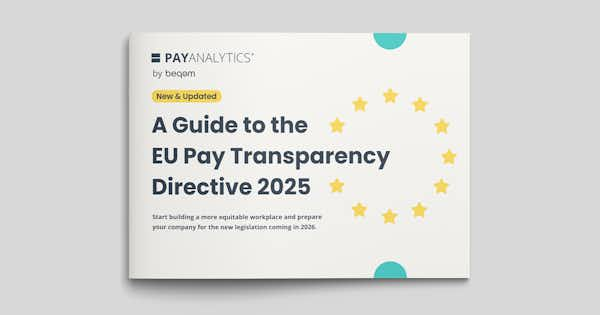A Guide to the EU Pay Transparency Directive 2025 | Download our eGuide for free

Slovakia takes action on EU Pay Transparency Directive
In May 2025, Slovakia’s Ministry of Labour, Social Affairs and Family confirmed that pay equity and transparency legislation would be forthcoming later in the year. This draft legislation was introduced in September 2025.
This article gives an overview of the pay equity landscape in Slovakia and provides details of the draft that would transpose the EU Pay Transparency Directive into national law.
The pay equity landscape in Slovakia
Slovakia has already taken legal measures to reduce gender-based pay discrimination. The nation’s Labor Code outlaws such discrimination and upholds the principle of equal pay. It also makes pay confidentiality agreements illegal, so employees can discuss or disclose their pay at will.
Yet despite these measures, Slovakia still struggles with pay inequity. Based on the most recent available data, Slovakia’s pay gap is relatively high at 15.7% (the EU average is around 12%).
Slovakia enacts new pay transparency laws
The new draft legislation would provide a full transposition of the EU Pay Transparency Directive.
To meet the EU Directive’s requirements, this legislation introduces a new law regarding pay transparency. It also amends some current laws, including parts of the Labor Code, the Labor Inspection Act, and the Employment Services Act.
The draft legislation was published on September 19th, 2025, and it is open for public comment and additional review until October 9th. Slovakia’s cabinet is expected to approve the legislation in late October, and it would become effective as of June 1st, 2026.
Here are the key elements of Slovakia’s draft legislation:
Pay transparency
- In job postings or before a job interview, employers must provide the position’s wage or salary, or wage/salary range.
- Job postings and titles must use gender-neutral language.
- Employers are not allowed to ask candidates about their current or past pay.
- Employers need to make pay decisions based on transparent pay structures based on objective, gender-neutral criteria that are documented and that employees can review.
- If any labor organization is present within the organization, employee representatives must approve the criteria being used.
- If an employee requests it, they are entitled to access pay information about categories of workers doing the same work or work of equal value. Employers have two months to respond to such requests.
Pay equity
Aligning with the directive’s requirements, Slovakia’s draft legislation would require organizations with 100 or more employees to submit pay gap reports. Organizations with 250 or more employees would need to report annually. Those with 100 to 249 employees would need to report every three years.
Initial reporting deadlines are as follows:
- 150 or more employees: June 7th, 2027
- 100 to 149 employees: June 7th, 2031
The reports would need to include all metrics specified by the EU Directive. These are:
- The gender pay gap.
- The gender pay gap in complementary or variable components.
- The median gender pay gap.
- The median gender pay gap in complementary or variable components.
- The proportion of female and male workers receiving complementary or variable components, broken down by gender.;
- The proportion of female and male workers in each quartile pay band, broken down by gender.
- The gender pay gap between workers by categories of workers broken down by ordinary basic salary and complementary or variable components.
- The proportion of workers who benefited from a pay rise following their return from maternity leave, paternity leave, parental leave, and carers’ leave broken down by gender.
- The average pay levels by category of workers broken down by gender.
If an employer reports a pay gap of over 5% in any category of workers, and if that gap cannot be explained by gender-neutral factors, the employer must either:
- Correct the gap within six months.
- Conduct a joint pay assessment and create a gender action plan within two months.
Slovakia’s draft legislation outlines enforcement mechanisms and penalties for noncompliance:
- The employer would bear the burden of proof in pay discrimination cases.
- If an employer violates Slovakia’s equal pay laws, the employee harmed may be entitled to financial compensation. There would be a three-year limitation period for claiming this compensation.
- Employers who do not comply with reporting obligations may face fines of up to EUR 4,000.
This new legislation very closely tracks the requirements of the EU Directive without going above or beyond. For a more in-depth look at these pay transparency, pay equity, and reporting requirements, our newly updated eGuide to the EU Directive can be downloaded for free.
Further support with PayAnalytics by beqom
Although employers in Slovakia may be familiar with pay transparency to some extent, compliance with the 5% pay gap target and the new reporting requirements will require planning in advance. Thinking forward to 2027, employers, especially those with 150 or more employees, should start closing their pay gaps now.
To do this, employers need effective data analysis tools that will help them identify the origin and size of gender pay gaps within the organization. PayAnalytics by beqom was designed for exactly this purpose. Designed by data scientists, our user-friendly tool identifies pay gaps and proposes targeted raises that you can optimize for a given budget and timeline. And by providing ongoing decision support, our Compensation Assistant feature evaluates potential pay decisions and their effect on your organization’s pay gap metrics, so you can make sure that pay gaps never reopen.
For up-to-date information on the unfolding transposition of the EU Pay Transparency Directive, in Slovakia and elsewhere, please keep an eye on our transposition tracker.
If you are curious about what we offer and how PayAnalytics by beqom can simplify EU Directive compliance and reporting for your organization, we encourage you to book a demo today.





